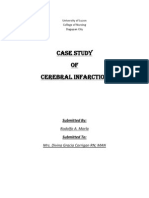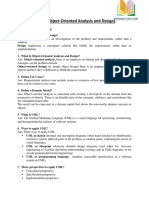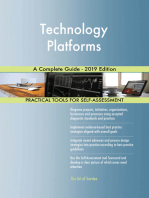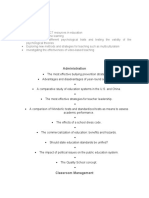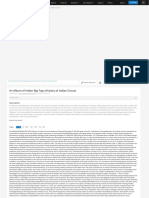0 ratings0% found this document useful (0 votes)
219 viewsEER Model: Enhance Entity Relationship Model
EER Model: Enhance Entity Relationship Model
Uploaded by
Haroon KhalidThe document discusses generalization, specialization, superclass, and subclass relationships in entity relationship modeling. It defines generalization as forming a higher entity by identifying commonalities between lower entities. Specialization splits a higher entity into lower entities by discovering differences. A superclass can have one or more subclasses that inherit its properties. Specialization maximizes differences while generalization minimizes them. The document provides examples and constraints of these relationships.
Copyright:
© All Rights Reserved
Available Formats
Download as PPTX, PDF, TXT or read online from Scribd
EER Model: Enhance Entity Relationship Model
EER Model: Enhance Entity Relationship Model
Uploaded by
Haroon Khalid0 ratings0% found this document useful (0 votes)
219 views12 pagesThe document discusses generalization, specialization, superclass, and subclass relationships in entity relationship modeling. It defines generalization as forming a higher entity by identifying commonalities between lower entities. Specialization splits a higher entity into lower entities by discovering differences. A superclass can have one or more subclasses that inherit its properties. Specialization maximizes differences while generalization minimizes them. The document provides examples and constraints of these relationships.
Original Description:
Entity relationship model
Original Title
EER Model
Copyright
© © All Rights Reserved
Available Formats
PPTX, PDF, TXT or read online from Scribd
Share this document
Did you find this document useful?
Is this content inappropriate?
The document discusses generalization, specialization, superclass, and subclass relationships in entity relationship modeling. It defines generalization as forming a higher entity by identifying commonalities between lower entities. Specialization splits a higher entity into lower entities by discovering differences. A superclass can have one or more subclasses that inherit its properties. Specialization maximizes differences while generalization minimizes them. The document provides examples and constraints of these relationships.
Copyright:
© All Rights Reserved
Available Formats
Download as PPTX, PDF, TXT or read online from Scribd
Download as pptx, pdf, or txt
0 ratings0% found this document useful (0 votes)
219 views12 pagesEER Model: Enhance Entity Relationship Model
EER Model: Enhance Entity Relationship Model
Uploaded by
Haroon KhalidThe document discusses generalization, specialization, superclass, and subclass relationships in entity relationship modeling. It defines generalization as forming a higher entity by identifying commonalities between lower entities. Specialization splits a higher entity into lower entities by discovering differences. A superclass can have one or more subclasses that inherit its properties. Specialization maximizes differences while generalization minimizes them. The document provides examples and constraints of these relationships.
Copyright:
© All Rights Reserved
Available Formats
Download as PPTX, PDF, TXT or read online from Scribd
Download as pptx, pdf, or txt
You are on page 1of 12
EER Model
Enhance Entity Relationship Model
Specialization/Generalization
Generalization and Specialization both the terms are more common in Object Oriented
Technology, and they are also used in the Database with the same features.
Generalization occurs when we ignore the differences and acknowledge the similarities
between lower entities or child classes or relations to form a higher entity.
However, when we moved on to the specialization, it spilt a higher entity to form lower
entities, then we discover the differences between those lower entities.
Generalization
Generalization is the process of generalizing the entities which contain the properties of
all the generalized entities.
It is a bottom approach, in which two lower level entities combine to form a higher level
entity.
Generalization is the reverse process of Specialization.
It defines a general entity type from a set of specialized entity type.
It minimizes the difference between the entities by identifying the common features.
For example:
In the above example, Tiger, Lion, Elephant can all be generalized as Animals.
Specialization
• Specialization is a process that defines a group entities which is divided into sub groups
based on their characteristic.
• It is a top down approach, in which one higher entity can be broken down into two lower
level entity.
• It maximizes the difference between the members of an entity by identifying the unique
characteristic or attributes of each member.
• It defines one or more sub class for the super class and also forms the
superclass/subclass relationship.
Example
In the above example, Employee can be specialized as Developer or Tester, based on what
role they play in an Organization.
Superclass
• Super class is an entity type that has a relationship with one or more
subtypes.
• An entity cannot exist in database merely by being member of any
super class.
For example: Shape super class is having sub groups as Square, Circle,
Triangle.
Subclass
• Sub class is a group of entities with unique attributes.
• Sub class inherits properties and attributes from its super class.
For example: Square, Circle, Triangle are the sub class of Shape super
class.
Superclass and Subclass Relationship
• Member of Subclass also member of superclass.
• The relationship between a superclass and a subclass is one-to-one
(1:1) and is called a superclass/subclass relationship.
Specialization Process and Generalization
Process
Specialization Process
• The process of maximizing the differences between members of an
entity by identifying their distinguishing characteristics.
Generalization Process
• The process of minimizing the differences between entities by
identifying their common characteristics
Constraints of Specialization & Generalization
There are two constraints of Specialization and Generalization
Constraints.
i. Participation Constraints
ii. Disjoint Constraints
Participation Constraints
• Determines whether every member in the superclass must participate
as a member of a subclass.
Disjoint Constraints
Describes the relationship between members of the subclasses and indicates
whether it is possible for a member of a superclass to be a member of one,
or more than one, subclass.
It depends on AND/OR
OR
One Row in a subclass can occur, Nor More then one can occur
AND
More then one row may occur in Subclass.
1. Mandatory, OR
2. Mandatory, AND
3. Optional, AND
4. Optional, OR
Aggregation and Composition
Aggregation
Represents a ‘has-a’ or ‘is-part-of’ relationship between entity
types, where one represents the ‘whole’ and the other the ‘part’.
Composition
A specific form of aggregation that represents an association
between entities, where there is a strong ownership and coincidental
lifetime between the ‘whole’ and the ‘part’.
You might also like
- Distributed System MCQDocument10 pagesDistributed System MCQalmuhtarif.egyptian.yahoo.comNo ratings yet
- Science 8 - Science in Action - Topics ABC - Lesson PlansDocument446 pagesScience 8 - Science in Action - Topics ABC - Lesson PlansLizaNo ratings yet
- Client Server Architecture A Complete Guide - 2020 EditionFrom EverandClient Server Architecture A Complete Guide - 2020 EditionNo ratings yet
- Service Manual 00891036.f06 enDocument792 pagesService Manual 00891036.f06 enWilson Rsm100% (2)
- Case Study Cerebral InfarctDocument11 pagesCase Study Cerebral InfarctRodel MorlaNo ratings yet
- Enhanced Entity Relationships ModelDocument27 pagesEnhanced Entity Relationships Modelbabylin_1988No ratings yet
- Unit - 9 System Construction and ImplementationDocument20 pagesUnit - 9 System Construction and ImplementationSAJAL KOIRALANo ratings yet
- Software Engineering Final PaperDocument3 pagesSoftware Engineering Final PaperSyed Saim100% (1)
- 7th Lecture Computer Security - PoliciesDocument4 pages7th Lecture Computer Security - PoliciesAli Al-HamdaniNo ratings yet
- Core Java Question Bank (Set-1)Document22 pagesCore Java Question Bank (Set-1)Amitav BiswasNo ratings yet
- Question Bank System Analysis and Design MCA 205Document5 pagesQuestion Bank System Analysis and Design MCA 205Aftab KhanNo ratings yet
- PST UnitVDocument14 pagesPST UnitVjoyshcNo ratings yet
- The Database System EnvironmentDocument2 pagesThe Database System EnvironmentPavithra Pavi100% (1)
- OOAD Detailed Course OutlineDocument6 pagesOOAD Detailed Course OutlineAhmadHassanNo ratings yet
- sathyabama-IIsem-Distributed Computing-683201-783201Document2 pagessathyabama-IIsem-Distributed Computing-683201-783201ShankarNo ratings yet
- Ch02 Data Models Ed7Document35 pagesCh02 Data Models Ed7Mohammed Adams67% (3)
- OOAD MCQ: Architectural ModelingDocument7 pagesOOAD MCQ: Architectural ModelingVINOD DNo ratings yet
- OOAD Question BankDocument5 pagesOOAD Question BankChidambaram100% (2)
- Chapter 4 - Naming: Distributed Systems (IT 441)Document68 pagesChapter 4 - Naming: Distributed Systems (IT 441)hiwot kebedeNo ratings yet
- Ambo University Woliso Campus: Advanced Database For 2 YearDocument48 pagesAmbo University Woliso Campus: Advanced Database For 2 YearTesfahun Maru100% (1)
- SAD McqsDocument3 pagesSAD McqsGenghis Khan 69No ratings yet
- Introduction To Computer NetworksDocument6 pagesIntroduction To Computer NetworksMahesh KhatiwadaNo ratings yet
- From Chapter 1 of Distributed Systems Concepts and Design, 4 EditionDocument49 pagesFrom Chapter 1 of Distributed Systems Concepts and Design, 4 Editionsunder V100% (1)
- Language Processing ActivitiesDocument14 pagesLanguage Processing ActivitiesarchtfNo ratings yet
- Star UMLDocument24 pagesStar UMLTirumala Placement Cell-hydNo ratings yet
- Unit 4 - Software Engineering - WWW - Rgpvnotes.inDocument12 pagesUnit 4 - Software Engineering - WWW - Rgpvnotes.inNazma QureshiNo ratings yet
- Software Engineering Mcqs Set1Document27 pagesSoftware Engineering Mcqs Set1MAHAMA SADIK100% (1)
- DSDocument9 pagesDSJayant KodamNo ratings yet
- Ad SW Final Revision Essay QuestionDocument4 pagesAd SW Final Revision Essay QuestionKAREEM Abo ELsouDNo ratings yet
- Unit IV OoadDocument68 pagesUnit IV OoadRam BehinNo ratings yet
- Semester: 8 Sem Subject: DOS Quiz BankDocument92 pagesSemester: 8 Sem Subject: DOS Quiz BankSAI RAMANNo ratings yet
- SE CH - 3 Software Requirement EngineeringDocument4 pagesSE CH - 3 Software Requirement EngineeringsahilNo ratings yet
- Chapter Five: Object-Oriented TestingDocument20 pagesChapter Five: Object-Oriented TestingMehari TemesgenNo ratings yet
- Viruses and Related Threats in SecurityDocument12 pagesViruses and Related Threats in Securityjim80% (5)
- NORMALIZATIONDocument51 pagesNORMALIZATIONAishwarya PillaiNo ratings yet
- Object Oriented System MethodologyDocument49 pagesObject Oriented System MethodologySagar NNo ratings yet
- Ambo University Woliso CampusDocument10 pagesAmbo University Woliso CampusTolosa TafeseNo ratings yet
- Ugc Net Questions For Computer Science DBMS PDFDocument3 pagesUgc Net Questions For Computer Science DBMS PDFChinmay borkerNo ratings yet
- DBMS LAB MANUAL FINAL (AutoRecovered)Document46 pagesDBMS LAB MANUAL FINAL (AutoRecovered)shwetha kNo ratings yet
- Comprehensive 1 PDFDocument154 pagesComprehensive 1 PDFSrinithy SaravananNo ratings yet
- Assignment of IOT ProtocolsDocument8 pagesAssignment of IOT ProtocolsOrion demeNo ratings yet
- Mc5024-Web Design ModelDocument2 pagesMc5024-Web Design ModelMsec McaNo ratings yet
- Data Mining - Bayesian ClassificationDocument6 pagesData Mining - Bayesian ClassificationRaj EndranNo ratings yet
- Software and Engineering (Questions and Answers-1)Document4 pagesSoftware and Engineering (Questions and Answers-1)dolon10100% (2)
- SPPM Unit 2Document44 pagesSPPM Unit 2divya reddyNo ratings yet
- Query OptimizationDocument30 pagesQuery OptimizationKrishna KumarNo ratings yet
- For OOAD PatternsDocument53 pagesFor OOAD PatternsYash Patel100% (1)
- Operating System Module Only For Exit Exam Preparation DawitDocument29 pagesOperating System Module Only For Exit Exam Preparation DawitFuad EdrisNo ratings yet
- RDBMS Unit 5Document39 pagesRDBMS Unit 5sruthigummadiNo ratings yet
- 18CS53 - Database Management SystemDocument52 pages18CS53 - Database Management SystemYASHASHWINI SNo ratings yet
- Unit: 1 Introduction To Distributed SystemDocument147 pagesUnit: 1 Introduction To Distributed SystemWashim AmjadNo ratings yet
- Unit-4 DS StudentDocument43 pagesUnit-4 DS StudentHarpreet Singh BaggaNo ratings yet
- Course Outline - Organisational Study of IS - 2021-2022Document7 pagesCourse Outline - Organisational Study of IS - 2021-2022Dery WalieriNo ratings yet
- A File System For Mobile ComputingDocument28 pagesA File System For Mobile ComputingHemant TulsaniNo ratings yet
- Unit 5 - Database Management System - WWW - Rgpvnotes.inDocument24 pagesUnit 5 - Database Management System - WWW - Rgpvnotes.inmroriginal845438No ratings yet
- Modeling and Detection of Camouflaging WormDocument37 pagesModeling and Detection of Camouflaging WormS Krishna SingaraiahNo ratings yet
- Short Questions of OOAD-solutionsDocument3 pagesShort Questions of OOAD-solutionsAqsa IramNo ratings yet
- Distributed 2 MarksDocument16 pagesDistributed 2 MarksVidhyaNo ratings yet
- BCA Practical ExercisesDocument8 pagesBCA Practical ExercisesMunavalli Matt K SNo ratings yet
- Network Management System A Complete Guide - 2020 EditionFrom EverandNetwork Management System A Complete Guide - 2020 EditionRating: 5 out of 5 stars5/5 (1)
- Difference Between Existing System and Proposed SystemDocument5 pagesDifference Between Existing System and Proposed SystemHaroon KhalidNo ratings yet
- Tentative ListDocument5 pagesTentative ListHaroon KhalidNo ratings yet
- University of Education Lahore D.G. Khan (Campus) : ProposalDocument3 pagesUniversity of Education Lahore D.G. Khan (Campus) : ProposalHaroon KhalidNo ratings yet
- Project Proposal For Blood Donation in KPMBDocument15 pagesProject Proposal For Blood Donation in KPMBHaroon KhalidNo ratings yet
- Research Topics For BDocument5 pagesResearch Topics For BHaroon KhalidNo ratings yet
- Research Topics For BDocument5 pagesResearch Topics For BHaroon KhalidNo ratings yet
- Rehan ArshadcvDocument2 pagesRehan ArshadcvHaroon KhalidNo ratings yet
- lh202 Specification Sheet English PDFDocument6 pageslh202 Specification Sheet English PDFLincolNo ratings yet
- Blind Spots - The Roots of Unethical BehaviourDocument5 pagesBlind Spots - The Roots of Unethical BehaviourMarta AntoninaNo ratings yet
- Exemptions of Article 3 of The Civil Code of The PhilippinesDocument2 pagesExemptions of Article 3 of The Civil Code of The PhilippinesMona LizaNo ratings yet
- Sample Question Paper: General Knowledge and Current AffairsDocument4 pagesSample Question Paper: General Knowledge and Current Affairsshano chaudharyNo ratings yet
- Mathematics: First Quarter - Week 4Document6 pagesMathematics: First Quarter - Week 4MARIE GRACE APARRENo ratings yet
- 23 Office AccountsDocument9 pages23 Office AccountsNguyenNo ratings yet
- An Album of Indian Big Tops (History of Indian Circus)Document5 pagesAn Album of Indian Big Tops (History of Indian Circus)A Surya TejaNo ratings yet
- Decide To Commit It.": Case of People of The R.P. vs. Pugay No. L-74324 17november1988Document2 pagesDecide To Commit It.": Case of People of The R.P. vs. Pugay No. L-74324 17november1988Ashley Kate PatalinjugNo ratings yet
- Selenium and WebdriverDocument9 pagesSelenium and WebdriverSangeetha BcNo ratings yet
- FT-2500M ServDocument76 pagesFT-2500M ServLuis BagarelliNo ratings yet
- Foreign Language 101Document2 pagesForeign Language 101Fanwa MichaelNo ratings yet
- Perubahan Sosial Masyarakat Nelayan Di Desa Cupel Kecamatan Negara Kabupaten JembranaDocument12 pagesPerubahan Sosial Masyarakat Nelayan Di Desa Cupel Kecamatan Negara Kabupaten Jembrana36Muhammad Rizal AfnaniNo ratings yet
- Ldla CV 01-13-19Document7 pagesLdla CV 01-13-19api-284788195No ratings yet
- Pet1 Test2Document19 pagesPet1 Test2Epoch100% (1)
- 1 27Document54 pages1 27MD Omar FarukNo ratings yet
- Talmakkies Case Judgment Over Magistrate 21.11.2023Document17 pagesTalmakkies Case Judgment Over Magistrate 21.11.2023Krash KingNo ratings yet
- NotesDocument5 pagesNotesKorrine FloresNo ratings yet
- Mahindra & Mahindra ProjectDocument75 pagesMahindra & Mahindra Projectnanda91100% (3)
- Capstone Proposal Final Like Medj FinalDocument22 pagesCapstone Proposal Final Like Medj FinalCABABAN, SHAIRA A. STEM2No ratings yet
- News Article SummaryDocument4 pagesNews Article Summaryapi-550030025No ratings yet
- 7 Innovation Habits 231117 R1Document2 pages7 Innovation Habits 231117 R1Prashant Yeshwant JoglekarNo ratings yet
- Detailed Lesson Plan in Rock CycleDocument14 pagesDetailed Lesson Plan in Rock CycleDanika Mae PondangNo ratings yet
- SM2ed Teacher - S Resources Worksheet J L3 U9Document6 pagesSM2ed Teacher - S Resources Worksheet J L3 U9Kaung Khant Ko KoNo ratings yet
- مدخل إلى المحاسبة في الفكر الاسلاميDocument405 pagesمدخل إلى المحاسبة في الفكر الاسلاميhamadaifoudaNo ratings yet
- World of Animals - Issue 3 "A Tiger's Tale"Document9 pagesWorld of Animals - Issue 3 "A Tiger's Tale"International Fund for Animal WelfareNo ratings yet
- CLIL - Content and Language Integrated Learning - PresentationDocument14 pagesCLIL - Content and Language Integrated Learning - PresentationTường CátNo ratings yet
- Chapter 6-10 QuestionsDocument3 pagesChapter 6-10 QuestionsNancy YouNo ratings yet




